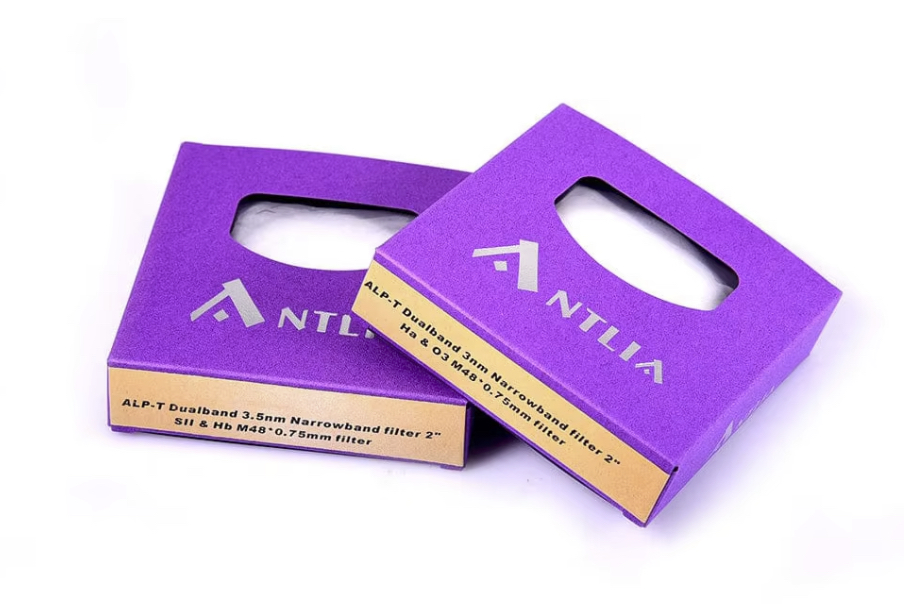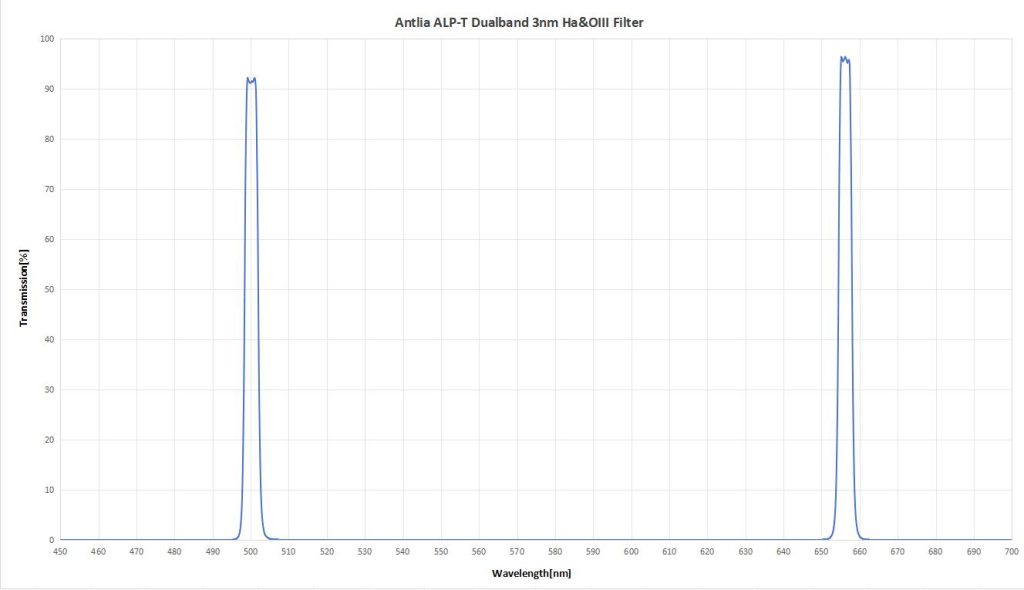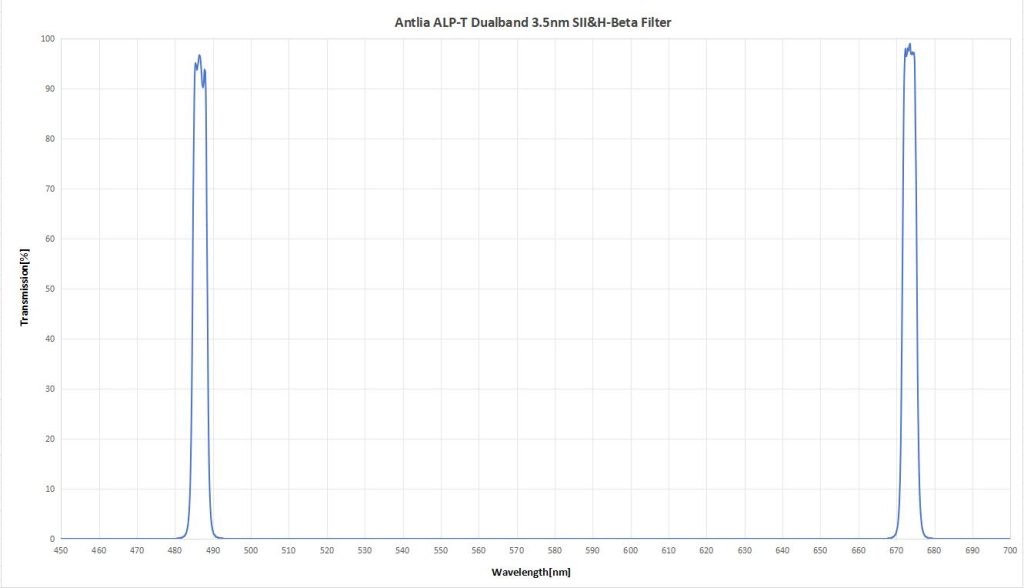1. Antlia ALP-T Dualband 3nm Ha & OIII Filter
Antlia designed the ALP-T Dualband 3nm Ha & OIII filter as a high-performance dual narrowband filter for colour cameras. It transmits the red H-alpha line at 656.3nm and the blue-green OIII line at 500.7nm, helping astrophotographers capture deep-sky images with superior signal-to-noise ratio (SNR). With an ultra-narrow 3nm FWHM and an optical density (OD) of 4.5, the filter blocks unwanted wavelengths, effectively cutting through light pollution, moonlight, and airglow. This precise filtering enhances nebula contrast by allowing only the Ha and OIII emission signals to pass.
For expanded imaging capability, Antlia also offers the ALP-T Dualband 3.5nm SII & H-beta filter. Together, these filters allow OSC (one-shot colour) users to capture all four major emission lines—Ha, OIII, SII, and H-beta. By separating and recombining these spectral channels during post-processing, you can create a wide range of false-colour palettes, such as H-O-Hb, S-H-O, H-S-OHb, and H-O-O. These palettes enhance image depth, contrast, and artistic flexibility, while also improving luminance contrast in traditional RGB images.
Antlia’s advanced multi-coatings ensure each dualband filter isolates its target emission lines with precision. The coatings suppress unwanted light with OD4.5 blocking, reducing interference from light pollution, moonlight, and airglow. Whether you’re imaging in urban or rural skies, these filters maintain high contrast and SNR, making them ideal for capturing more detailed and vibrant celestial images.
Application and performance:
-
Passes OIII at 500.7nm and H-alpha at 656.3nm
-
Captures two key emission wavebands—red and blue-green—simultaneously
-
Features an ultra-narrow 3nm FWHM design, allowing longer exposures and capturing fine nebular details
-
Designed primarily for colour cameras to collect cleaner data
-
Also functions as a luminance filter for monochrome cameras, saving imaging time
-
Works best when paired with the ALP-T Dual Band SII & H-beta filter, enabling four-channel imaging (Ha, OIII, SII, H-beta) with improved signal-to-noise ratio and channel separation
-
Suppresses unwanted wavelengths with OD4.5 optical density, boosting signal-to-noise for clearer, high-contrast images
Spectrum Curve:
2. Antlia ALP-T Dualband 3.5nm SII & H-beta Filter
The ALP-T Dualband 3.5nm SII & H-beta filter complements the Ha & OIII version, giving astrophotographers the ability to capture additional emission lines in deep-sky objects. It transmits the deep red Sulphur-II line at 672.4nm and the blue Hydrogen-beta line at 486.1nm. Engineered primarily for colour cameras, this filter enhances your imaging by delivering higher signal-to-noise ratio and improved contrast. The narrow 3.5nm FWHM and OD4.5 blocking efficiently suppress light pollution, moonlight, and airglow, allowing only the SII and H-beta signals to pass.
This filter is a valuable addition to the Ha & OIII setup, enabling OSC users to produce narrowband and false-colour images with greater flexibility. When paired with the Ha & OIII filter, it allows you to capture four distinct spectral channels (Ha, OIII, SII, and H-beta), which can then be separated and recombined in post-processing. This combination lets you build custom colour palettes, enhance contrast, and reveal finer details within nebulae that standard RGB imaging often misses.
As with the Ha & OIII filter, the SII & H-beta version features Antlia’s advanced multi-coatings. These coatings precisely isolate the desired wavelengths and suppress unwanted light with OD4.5 performance, ensuring consistent results across different sky conditions. Whether imaging in light-polluted urban environments or under dark rural skies, both filters maintain superior contrast and deliver cleaner data for high-quality astrophotography.
Together, the ALP-T Dualband Ha & OIII and SII & H-beta filters unlock full narrowband imaging potential for OSC users. They provide the tools needed to create striking, detailed images of the night sky with minimal interference and maximum flexibility.
Application and Performance:
-
Passes Sulphur-II (SII) at 672.4nm and Hydrogen-beta (H-beta) at 486.1nm
-
Captures two key emission wavebands—deep red and blue—simultaneously
-
Features an ultra-narrow 3.5nm FWHM design for longer exposures and detailed nebula capture
-
Designed primarily for colour cameras to record cleaner data
-
Also works as a luminance filter for monochrome cameras, reducing imaging time
-
Recommended for use with the ALP-T Dual Band Ha & OIII filter to achieve better signal-to-noise ratio (SNR) and improved channel separation across Ha, OIII, SII, and H-beta
-
Suppresses unwanted wavelengths with OD4.5 optical density, enhancing SNR
-
Blocks near-infrared (NIR) wavelengths up to 1100nm to prevent signal contamination
-
Maintains spectral accuracy with a flat-top, moderate bandpass that reduces spectral shifts
-
Delivers best performance with optics slower than f/4; for faster systems, use the pre-shifted highspeed version
-
Uses Ion Gun Assisted Deposition to apply double-sided multi-layer coatings on polished substrates for consistent and precise light pollution suppression
-
Features anti-reflective halo suppression coatings to minimise halos and internal reflections
-
Effectively suppresses artificial lighting across Bortle scale 1 to Bortle scale 8 conditions
-
Includes blackened edges (on unmounted versions) to reduce internal reflections
-
Built with Antlia’s trusted coating technology for outstanding durability
-
Performs exceptionally with both colour and monochrome cameras, helping to save imaging time
Spectrum Curve:
Filter Ring:
2” (M48*0.75)
Ultra-thin filter cell to minimize vignetting by maximize possible clear aperture
Black Anodized Finish
Laser Engraving No Fading
Not Recommended:
Solar imaging
Night visual observation




Reviews
There are no reviews yet.